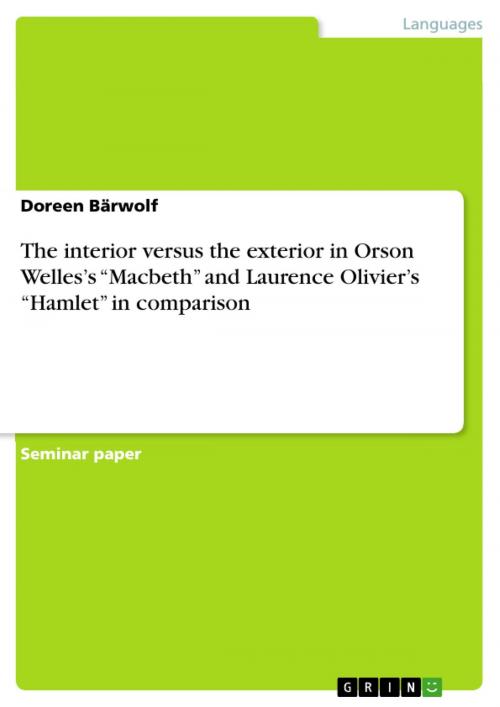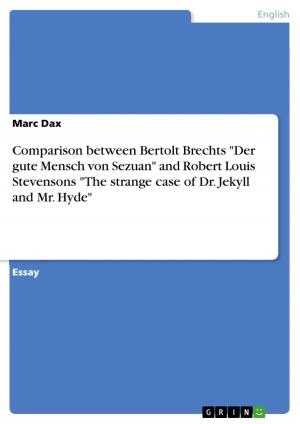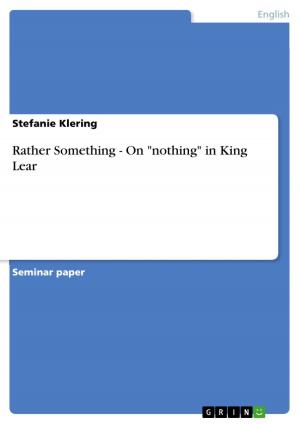The interior versus the exterior in Orson Welles's 'Macbeth' and Laurence Olivier's 'Hamlet' in comparison
Fiction & Literature, Literary Theory & Criticism, British| Author: | Doreen Bärwolf | ISBN: | 9783640694174 |
| Publisher: | GRIN Publishing | Publication: | September 1, 2010 |
| Imprint: | GRIN Publishing | Language: | English |
| Author: | Doreen Bärwolf |
| ISBN: | 9783640694174 |
| Publisher: | GRIN Publishing |
| Publication: | September 1, 2010 |
| Imprint: | GRIN Publishing |
| Language: | English |
Seminar paper from the year 2008 in the subject English - Literature, Works, grade: 2,7, http://www.uni-jena.de/ (Anglistisch/Amerikanistisches Institut), course: Hauptseminar: Shakespeare in the movies, language: English, abstract: Shakespeare was, arguably, the most interesting author of the Renaissance and still is one of the most taught and influential writers today. That is also the reason for so many films being based on Shakespeare's tragedies and comedies. The most successful period of making movies on Shakespearean dramas in history was the twentieth century. Very well-known and talented directors of the time challenged each other in making Shakespearean movies. Most successful for example were Sven Gade with his silent movie of Hamlet, Franco Zefferelli using Mel Gibson's talent also in Hamlet, as well as Kenneth Brannagh and many others. However the most famous films are the Shakespeare adaptations of Laurence Olivier and Orson Welles. Both had a lot of talent in being director, main actor and producer in one person in most of their productions. Because of their very interesting version and vision of Shakespeare, the Hamlet adaptation by Laurence Oliver and the Macbeth adaptation by Orson Welles will be the subject of this paper. The first topic in the first chapter of this assignment will be Laurence Olivier with his adaptation of Shakespeare's Hamlet. There will be a discussion on the concept of his film in general, which includes Olivier's vision of the setting, the time the film takes place in and the cutting of original scenes in Shakespeare. The centre of this paper will be the discussion of the interior and exterior elements of the film, influencing each other contrastively. The third chapter will discuss Orson Welles's adaptation of Macbeth. Similar to the previous chapter, the concept and the background of the film will be examined and hence the special methods of Welles to express the interior and exterior elements of his movie will be discussed. According to this research of both films a summery will show, that the two diverse versions of two different Shakespearean plays are in many ways similar to each other, besides being released in the same year.
Seminar paper from the year 2008 in the subject English - Literature, Works, grade: 2,7, http://www.uni-jena.de/ (Anglistisch/Amerikanistisches Institut), course: Hauptseminar: Shakespeare in the movies, language: English, abstract: Shakespeare was, arguably, the most interesting author of the Renaissance and still is one of the most taught and influential writers today. That is also the reason for so many films being based on Shakespeare's tragedies and comedies. The most successful period of making movies on Shakespearean dramas in history was the twentieth century. Very well-known and talented directors of the time challenged each other in making Shakespearean movies. Most successful for example were Sven Gade with his silent movie of Hamlet, Franco Zefferelli using Mel Gibson's talent also in Hamlet, as well as Kenneth Brannagh and many others. However the most famous films are the Shakespeare adaptations of Laurence Olivier and Orson Welles. Both had a lot of talent in being director, main actor and producer in one person in most of their productions. Because of their very interesting version and vision of Shakespeare, the Hamlet adaptation by Laurence Oliver and the Macbeth adaptation by Orson Welles will be the subject of this paper. The first topic in the first chapter of this assignment will be Laurence Olivier with his adaptation of Shakespeare's Hamlet. There will be a discussion on the concept of his film in general, which includes Olivier's vision of the setting, the time the film takes place in and the cutting of original scenes in Shakespeare. The centre of this paper will be the discussion of the interior and exterior elements of the film, influencing each other contrastively. The third chapter will discuss Orson Welles's adaptation of Macbeth. Similar to the previous chapter, the concept and the background of the film will be examined and hence the special methods of Welles to express the interior and exterior elements of his movie will be discussed. According to this research of both films a summery will show, that the two diverse versions of two different Shakespearean plays are in many ways similar to each other, besides being released in the same year.















